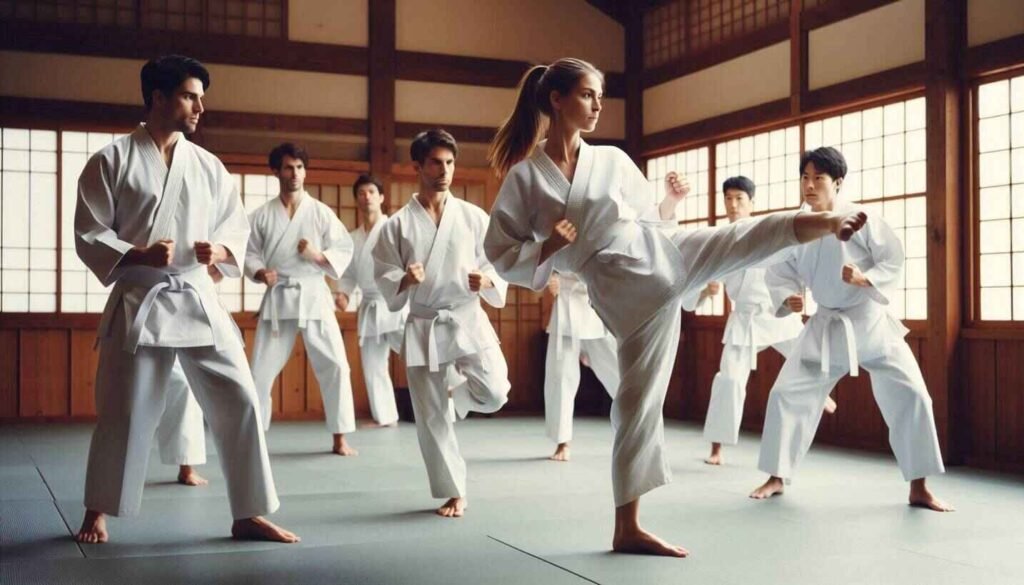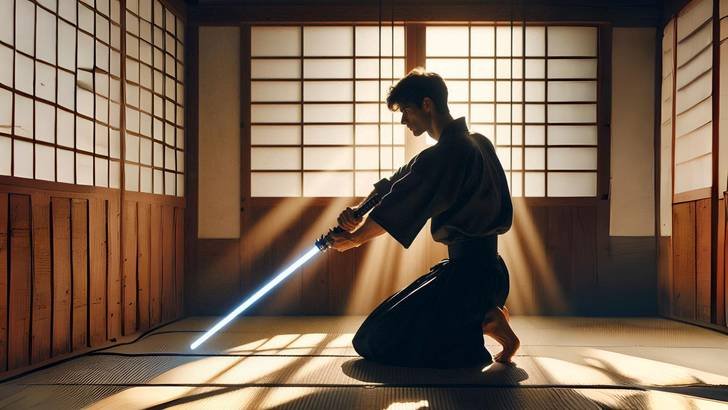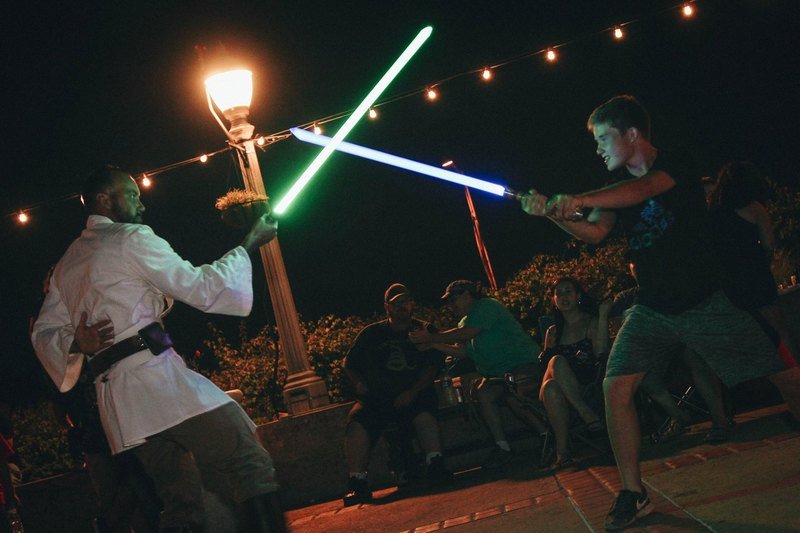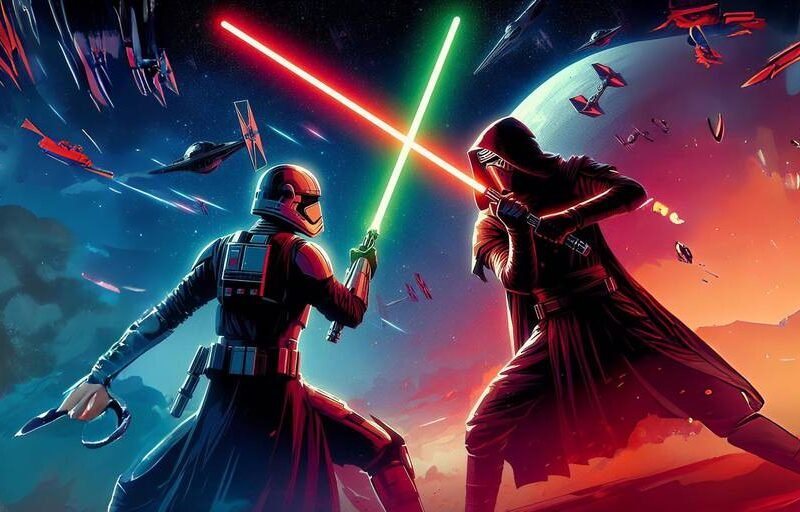Lightsaber combat, popularized by “Star Wars,” is more than just a fictional concept. In recent years, it has evolved into a structured practice with dedicated schools and enthusiastic practitioners. These combatants don’t aim to harm but rather to engage in a sport that is both fast-paced and enjoyable. This reimagining of a combat sport draws on traditional martial arts and fencing techniques, showing a unique blend of ancient practices and modern entertainment.
Martial arts are seen as fighting systems with historical and cultural backgrounds that have changed over time. As society changes, the interpretations and applications of these arts evolve as well. Lightsaber combat offers a new way to look at these changes.
Martial arts studies is a growing field that seeks to understand these changes. Researchers in this area are not just looking at the techniques and physical aspects of martial arts but also at their cultural, social and philosophical implications. Defining what is or isn’t a martial art is complex because it involves seeing how these practices fit into broader social and cultural contexts.
In this article, we’ll answer the question: “Is lightsaber combat a martial art?” To do that, we first need to understand what martial arts mean today.
What are Martial Arts?
Martial arts are structured systems of combat practices designed for self-defense, military training, and physical or spiritual development. These practices are often deeply rooted in cultural traditions and encompass technical, philosophical, and ethical components. From karate and kung fu to fencing and taekwondo, martial arts emphasize discipline, respect, and personal growth, fostering tight-knit communities united by shared values.
Historically, martial arts evolved from the combat strategies of ancient warriors, adapting to modern contexts as sports or tools for self-improvement. This adaptability illustrates the complexity and diversity of martial arts, challenging rigid definitions while showcasing their cultural richness.

How Are Martial Arts Traditionally Defined?
Martial arts are traditionally defined as systems of combat practices developed for self-defense, military training and physical conditioning. These systems often include a set of techniques, forms and training methods passed down through generations. Common examples of traditional martial arts include karate, taekwondo, judo and kung fu, each with its unique history, philosophy and techniques.
Traditional martial arts emphasize discipline, respect and personal development. Practitioners are often required to adhere to a code of conduct, demonstrating respect for their instructors, fellow students and the art itself. The training process typically involves rigorous physical conditioning, technical drills and sparring or competitive matches.
What Are the Social and Cultural Aspects of Martial Arts?
From a sociological perspective, martial arts are not just about fighting techniques but also about the social and cultural practices that surround them. Martial arts often reflect the values and philosophies of the cultures from which they originate. For example, aikido in Japan emphasizes harmony and non-aggression, matching the cultural value of seeking peace and avoiding conflict.
Martial arts also play an important role in shaping cultural identity and community. Practitioners often form tight-knit communities, bonding over shared experiences and values. These communities provide a sense of belonging and support, fostering personal growth and mutual respect.
Why Is Historical Context Vital in Understanding Martial Arts?
The historical context of martial arts is crucial in understanding their development and significance. Many martial arts have roots in the ancient military traditions of their respective cultures. For instance, kendo evolved from the swordsmanship practices of the samurai in Japan, while kung fu has origins in the physical and spiritual training of Shaolin monks in China.
Historical context also helps to explain the evolution of martial arts. For example, Many traditional martial arts used for war have shifted focus to self-defense, fitness and sport. Understanding this evolution helps us see why martial arts remain popular and relevant today.
What Are the Challenges in Defining Martial Arts?
Defining martial arts is complex because of their diverse nature and purposes. Traditional definitions often focus on combat aspects, but this is limiting since martial arts also involve physical, mental and spiritual growth.
For example, some definitions emphasize the technical aspects of martial arts, focusing on the specific techniques and forms practiced. Others highlight the philosophical and ethical dimensions, considering martial arts as a means of personal and spiritual growth. These varying definitions reflect the multifaceted nature of martial arts and the challenges in developing a universal definition.
Should Martial Arts Be Universally or Culturally Defined?
Universal definitions of martial arts attempt to include all forms under one category, focusing on common elements like combat techniques and training methods. This approach seeks to identify the core aspects of martial arts regardless of cultural or historical context.
Relativistic definitions, on the other hand, consider the cultural and social contexts in which martial arts are practiced. This approach acknowledges the diversity and unique characteristics of each form, recognizing that martial arts can have different meanings and purposes in different cultures. For instance, capoeira in Brazil is not only a martial art but also a cultural expression and form of resistance.
What Are the Contributions of Peter Lorge and Sixt Wetzler to Martial Arts Studies?
Peter Lorge and Sixt Wetzler are scholars who have made substantial contributions to the academic study of martial arts.
Peter Lorge, in his book “Chinese Martial Arts: From Antiquity to the Twenty-First Century”, emphasizes the historical and cultural contexts of martial arts, arguing that these factors are essential in understanding their development. He believes martial arts can’t be fully understood without their historical origins and cultural meanings.
Sixt Wetzler proposes a more flexible framework for defining martial arts by identifying five dimensions of social meaning that martial arts can impact: preparation for violent conflict, play and competitive sports, performance, transcendent goals and health care. This framework allows for a broader interpretation of what can be considered a martial art, accommodating the diversity and complexity of martial practices.
What Is Lightsaber Combat?
Lightsaber combat combines martial arts, fencing, and performance in a structured form inspired by Star Wars. It began as fans recreating iconic duels from the films but has since expanded into a formalized practice with schools, competitions, and safety measures like padded lightsabers. Practitioners train in choreographed techniques, blending physical skill with artistic performance.

What Are the Roots of Lightsaber Combat?
The concept of lightsaber combat originates from the Star Wars universe, where Jedi and Sith use lightsabers with their mastery of the Force, which enhances their combat abilities. The acrobatic fight scenes in the movies inspired fans to recreate these duels in real life.
Lightsaber combat began with fans imitating movie scenes using homemade lightsabers. Over time, it became more structured, with schools and instructors teaching lightsaber techniques. The internet and social media helped spread lightsaber combat, allowing practitioners to connect, share techniques and organize events.
What Techniques and Training Are Used in Lightsaber Combat?
Lightsaber combat includes various elements from traditional martial arts and fencing. Practitioners learn specific forms and techniques based on the seven lightsaber forms from Star Wars. These forms include movements and stances for different combat situations like offense, defense and disarming opponents.
Training in lightsaber combat typically involves learning and practicing these forms, as well as sparring with other practitioners. Safety is important, so padded lightsabers and protective gear are used to prevent injuries. Lightsaber combat also includes performance elements, with practitioners creating and performing duels for entertainment and competition.
Why Has Lightsaber Combat Gained Popularity?
Lightsaber combat has grown in popularity, with many schools and academies offering classes and workshops. Events and competitions are held worldwide, attracting people from diverse backgrounds. Lightsaber combat bridges fiction and reality, creating a unique and engaging experience for fans.
The popularity of lightsaber combat is evident in its widespread presence in popular culture. It has been featured in different media, including documentaries, TV shows and social media platforms. This extensive exposure has helped establish lightsaber combat as both a form of entertainment and a recognized martial arts practice.
Can Lightsaber Combat Be Considered a Martial Art?
Yes, lightsaber combat can be viewed as a martial art. It incorporates key elements of traditional martial arts, such as structured training, technical proficiency, and personal development, while fostering a community rooted in shared values. Its physical and philosophical dimensions, as well as its competitive and performative aspects, align with modern martial arts practices.
Despite its fictional origins, lightsaber combat transcends mere entertainment. It embodies the principles of martial arts by offering practitioners opportunities for growth, discipline, and camaraderie, affirming its legitimacy as a unique and modern martial art form.

To determine if lightsaber combat can be considered a martial art, we can analyze it through traditional lenses. This involves examining the techniques, training methods and goals of lightsaber combat and comparing them to those of established martial arts.
How Does Lightsaber Combat Compare to Other Martial Arts?
Lightsaber combat draws heavily from historical European swordsmanship, particularly from the techniques used in fencing and other forms of sword fighting. Historical European Martial Arts (HEMA) practitioners have contributed to the development of lightsaber combat by incorporating techniques and training methods from historical swordsmanship manuals.
In addition to historical influences, lightsaber combat also incorporates elements of modern combat sports. The emphasis on physical fitness, agility and precision is similar to that found in sports such as fencing, kendo and taekwondo. The competitive aspect of lightsaber combat, with tournaments and matches, further aligns it with modern combat sports.
What Makes Lightsaber Combat Unique Among Martial Arts?
One of the unique aspects of lightsaber combat is its emphasis on play and performance. Practitioners often engage in choreographed duels that resemble theatrical performances. This aspect highlights the art’s connection to entertainment and cultural expression. The performance element allows practitioners to showcase their skills and creativity, similar to the performance aspect found in traditional martial arts such as wushu and capoeira.
Lightsaber combat also has transcendent goals, as practitioners seek personal growth and a deeper connection to the fictional universe they admire. The practice can provide a sense of escapism and immersion, allowing practitioners to embody the principles and values of the Jedi or Sith. This transcendent aspect aligns with the spiritual and philosophical dimensions found in many traditional martial arts.
Is Lightsaber Combat an Example of Hyper-Real Martial Arts?
Lightsaber combat exemplifies hyper-real martial arts, where fictional elements are transformed into real-world practices. Drawing from Umberto Eco’s theory of hyper-reality, it demonstrates how cultural phenomena can blur the lines between fiction and reality. By recreating the Star Wars universe through physical practice, lightsaber combat builds a unique cultural and social identity.
This hyper-real framework enhances its appeal, allowing practitioners to connect with both the fictional world and real-world martial arts traditions. As a hyper-real martial art, lightsaber combat redefines traditional boundaries, enriching the martial arts landscape with its imaginative and inclusive approach.

What Is the Concept of Hyper-Reality in Martial Arts?
The concept of hyper-reality, as introduced by Umberto Eco, refers to the creation of a reality based on fiction that becomes a part of our cultural understanding. Lightsaber combat fits into this category as it takes a fictional concept and brings it into the real world through structured practice and community building.
How Does Umberto Eco’s Theory of Hyper-Reality Apply to Lightsaber Combat?
Umberto Eco’s theory of hyper-reality suggests that certain phenomena blur the lines between fiction and reality. In the case of lightsaber combat, practitioners immerse themselves in a fictional universe, adopting its principles and practices in their real-world training and interactions.
Eco’s theory helps us understand the cultural significance and appeal of lightsaber combat. By practicing a beloved fictional universe, practitioners create a new form of cultural expression that is both a tribute to the source and a unique activity.
Why Should Lightsaber Combat Be Seen as a Hyper-Real Martial Art?
Given its structured practices, cultural significance and dedicated following, lightsaber combat arguably meets many criteria of traditional martial arts, albeit through a hyper-real lens. It combines elements of historical martial arts, modern combat sports and performance, creating a unique and engaging experience for practitioners.
As a hyper-real martial art, lightsaber combat challenges traditional definitions and expands the boundaries of what can be considered a martial art. It demonstrates how popular culture can inspire new forms of physical and cultural practices, enriching our understanding of martial arts and their place in contemporary society.
What Are the Practical and Social Implications of Lightsaber Combat?
Lightsaber combat fosters community, identity, and creativity. Its practitioners form supportive networks through shared interests, organizing events and competitions that emphasize respect and cooperation. Classes often integrate elements of traditional martial arts, such as discipline and meditation, alongside technical drills and choreographed performances.
Public perception of lightsaber combat is evolving. While some view it as entertainment, others recognize its cultural and technical merits. As it gains legitimacy through formalized training programs and competitions, lightsaber combat bridges the gap between fan culture and martial arts, demonstrating the power of imagination to inspire meaningful, real-world practices.

How Is Lightsaber Combat Taught and Practiced?
Training in lightsaber combat involves learning various forms, techniques and choreographed sequences. Schools and academies have sprung up globally, offering classes and workshops to enthusiasts. These institutions often draw from traditional martial arts, adapting techniques to fit the unique aspects of lightsaber combat.
Instructional approaches in lightsaber combat vary, with some schools emphasizing the technical and competitive aspects, while others focus on the performance and theatrical elements. Classes typically include warm-up exercises, technical drills, sparring sessions and choreography practice. Instructors may also incorporate elements of traditional martial arts training, such as meditation and philosophical discussions, to enhance the overall experience.
How Does Lightsaber Combat Build Community and Identity?
The community aspect of lightsaber combat is very important. Practitioners build strong connections through shared interests and activities, fostering a sense of identity and belonging. They frequently engage in events, competitions and social gatherings, which further reinforce their community bonds.
Lightsaber combat communities provide a supportive environment for practitioners to learn and grow. These communities often emphasize values such as respect, discipline and cooperation, mirroring the principles found in traditional martial arts. The shared passion for the Star Wars universe also creates a unique cultural connection, fostering a sense of camaraderie and mutual appreciation.
How Is Lightsaber Combat Viewed by the Public?
Public perception of lightsaber combat varies, with some viewing it as a legitimate martial art and others seeing it as a form of fan entertainment. As the practice continues to grow and gain recognition, it may achieve greater acceptance within the broader martial arts community and the public at large.
Efforts to legitimize lightsaber combat include hosting formal competitions, developing standardized training programs and gaining recognition from martial arts organizations. These efforts help to elevate the practice and showcase its technical and cultural merits. Increased media coverage and positive public reception can also contribute to greater acceptance and appreciation of lightsaber combat as a legitimate martial art.
Is Lightsaber Combat a Legitimate Martial Art?
Is lightsaber combat a martial art? The answer is almost certainly yes. Lightsaber combat is considered a martial art because it incorporates techniques from traditional martial arts and creates meaningful experiences for its practitioners. Students find personal and social value in it, similar to those found in traditional martial arts.
Critics argue that lightsaber combat lacks historical depth and practical application compared to traditional martial arts. However, the growing interest and debate around it underscore its recognition as a legitimate martial art.
All martial arts, even the ones with a long history, are always being renewed and reinvented. Lightsaber combat is valuable precisely because it makes us pay attention to how this process happens in certain communities. To fully appreciate it, we need to understand that these hyper-real combat practices can be real martial arts.
Explore Our Lightsaber Collection
Tony Allen is a writer for LightsabersBlog.com, a website focused on everything related to lightsabers. Tony grew up in Austin, Texas, and went on to study Mechanical Engineering at the University of Texas. Passionate about science fiction and fantasy, Tony has always been deeply involved in hobbies like tabletop RPGs, sci-fi novels, miniature painting, and crafting. This love for creative pursuits drives Tony to write about lightsabers in a way that ignites the imagination of fans around the world.








































